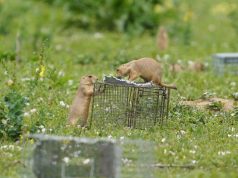This spring, like many Boulder residents with even a tiny scrap of lawn, I looked out my window and was appalled to see that hundreds of bright yellow dandelions had taken over. I quickly went to work trying to pull them out, but almost all of them were back the next week. Many homeowners and gardeners experience the same struggle, spending hours on hands and knees trying to force these weeds out.
There are others, though, who have learned to embrace weeds — plants that are considered a nuisance and a candidate for removal — and even incorporated them into their daily diets.
To find out if these Boulder weed eaters were really onto something, I went on two “weed walks” with local herbalists. Though I expected to go up to Chautauqua or venture out onto some unknown trail, both of the walks stayed in town in residential areas. My surprise that we would not need to leave the comfort of downtown Boulder was overcome only by my surprise at finding out just how many edible weeds there are. On both walks we stopped every couple of feet to examine another plant, growing straggly and wild out of the ground and just begging to be torn out to make room for something prettier or tastier. But each time, the herbalists handled the weeds with care, and explained their many uses for foods, drinks and medicines.
Brigitte Mars, Boulder herbalist and author, has been eating such weeds since her childhood, and still gets some of her food from plants that grow around her home in downtown Boulder.
“It seemed like a way that we could feed more people on the planet,” Mars says. “It struck me that a lot of people were wasting their land and using chemicals to kill plants that are edible so that they could grow grass, which is not all that useful. And that seemed kind of silly to me.”
Mars suggests that we could become healthier individuals and improve the health of the planet by learning to work with weeds, rather than against them.
“Weeds are survivors,” Mars says. “They’ve adapted to survive where nothing else has, so they’re very hearty.”
To live in environments that are often harsh, many weeds have developed ways of retaining nutrients more effectively, says Kat Mackinnon, a clinical herbalist and nutritionist in Boulder. These nutrients can include beta-carotene, vitamins A, B and C, omega 3 fatty acids, calcium, potassium, iron — the list goes on. Many weeds, like dandelions, have extremely deep taproots, which allow them to draw these nutrients up from deep, rich soils, Mackinnon says. These nutrients stay in the weeds when they are picked, making them nutritious additions to any diet.
Edible weeds can also be a great way to stick with the trend of eating local foods.
“It really doesn’t get more local than this,” Mackinnon says. “You know exactly where the weed comes from, and you reduce your carbon footprint by not shipping it anywhere.”
Both herbalists stress the importance of knowing exactly what a plant is before deciding to eat it. Mars and Mackinnon suggest taking a weed walk or buying an edible plant book before making a salad out of your backyard.
Many weeds can be used as medicinal teas or as salad greens, while others require more preparation.
Here are a few of the edible weeds around Boulder that might be found in a book or on a walk.
Dandelion: On both walks, I saw an abundance of dandelions rearing their little golden heads. One of the most common and most hated weeds, dandelions can also be some of the most useful, as the entire plant is edible. The flower of the dandelion has a subtle sweetness and can be used to make wine or eaten fried as a snack. Dandelion greens are popular in mixed green salads, and their bitter flavor is comparable to escarole. Mars suggests eating the leaves in early spring, but the roots can be eaten at any time of year.
“If you can eat the leaves before the plant flowers, they’ll be less bitter,” Mars says.
Lamb’s quarters: The light green leaves of lamb’s quarters have an easily recognizable shape, even for someone with little horticultural knowledge (like me), as they look like miniature goose tracks. Also known as wild spinach, lamb’s quarters can be a great money-saver if substituted for store-bought spinach. Lamb’s quarters are especially high in iron and calcium.
“People are always working hard to grow spinach or spending money to buy it at the store, when lamb’s quarters taste almost exactly the same,” Mars says. “And most people have it growing wild in their backyards.”
Mallow: Biting into a mallow leaf is like taking a drink of water. The leaves have an oddly moist quality, which is refreshing and delicious on the tongue.
“Mallow can be incredibly soothing if made into a tea,” Mackinnon says.
A tea made from mallow roots or leaves can help alleviate sore throats and coughs.
Purslane: Purslane is a small plant with a long-standing reputation as an invasive weed. It grows easily even in rocky landscapes, but its tiny leaves conceal a big flavor.
“It has an amazing tangy taste, and a little bit of a crunchy texture,” Mackinnon says. “Purslane makes a great pesto.”
Nettles: Touching a Lamb’s quarters stinging
nettle is an unpleasant experience — I brushed up against one on my
second walk, and my big toe itched and stung for the next 20 minutes.
Apparently though, eating it — cooked — is not so bad. The leaves lose
their stinging quality when boiled or steamed, and are tasty in soups.
Just make sure you put gloves on before harvesting your own.
“Nettles can also help with circulation, getting rid of cellulite and wrinkles,” Mars says.
Yellow dock: Commonly
seen on roadsides, in fields and in other untended areas, yellow dock
is a member of the buckwheat family. The leaves can be eaten in the
spring and have a sour taste, and the seeds can be used in cereal and
breads.
“I became gluten-free a couple of years ago, and I made a yellow dock flour that was a great substitute,” Mackinnon says.
There
are many more edible weeds that grow naturally in Boulder, and knowing
how to identify them can help save money and improve your diet.
“I
learned about lamb’s quarters about a week ago,” says Kathleen Wills, a
Boulder resident attending one of Mars’ weed walks. “Ever since then, I
bet I’ve saved about $15 by eating it instead of buying spinach.”
Though
these herbalists tout the benefits of edible weeds, Steve Sauer, weed
coordinator for Boulder County’s Weed Management Division, does not share that fondness.
“Weeds
have a definite effect on the ecosystem here in the county, not only on
public lands, but private lands,” Sauer says. “Weeds are super
competitors and they will out-compete native grasses or out-compete native
tree species. We’re all about making sure that the native vegetation is
there and that’s why weed control is very important.”
The
Weed Management Division uses an integrated weed management plan to
eradicate weeds like Mediterranean sage, knapweed and myrtle spurge.
Tactics include mechanical control, which is any mowing or hand-pulling;
cultural control, which includes re-vegetating and encouraging the
growth of desirable grasses; bio-control, where insects are released
onto the weeds; and chemical control, in which an area is spottreated
with herbicide, Sauer says.
The
list of weeds that the county is charged with controlling is long, but
does not include most of the weeds seen on a weed walk, such as
dandelions and lamb’s quarters. Because those weeds are “domestic,”
growing mostly in lawns and gardens, they are generally left to the care
of the homeowners, Sauer says.
As
far as eating weeds goes, Sauer says people are welcome to eat weeds,
but that the effect on weed populations is probably negligible.
“I
don’t really think enough people eat those kinds of weeds to make a lot
of difference,” Sauer says. “There are so many dandelions and so much
lamb’s quarters around, it would be hard for people to eat enough to
actually help control them.”
Respond: [email protected]














